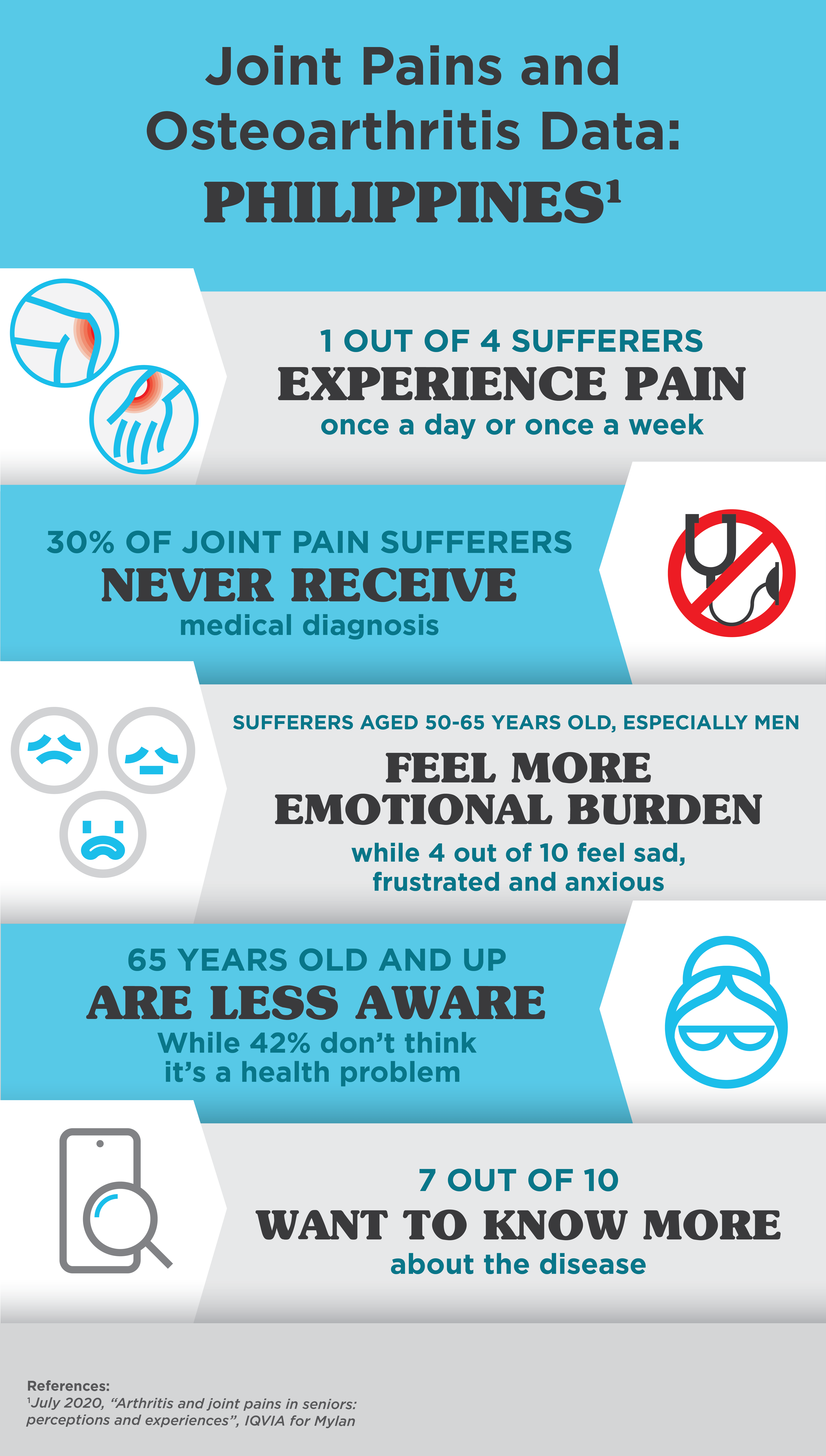In the Philippines, around 4.2 million people suffer from osteoarthritis,2 a condition characterized by joint pain which can limit daily activities like walking. Osteoarthritis (OA) is a chronic disease that primarily affects the cartilage, structures that protect the ends of bones within the joints.
Joint pain and osteoarthritis affect more people, and in more ways, than we might realize. As more and more Filipinos are finding it difficult to seek medical advice during this time of uncertainty, it’s important to educate the public about joint pain and osteoarthritis, as well as the potential consequences of delayed treatment.
Filipinos suffering from joint pain have an average age of 61 years, and 1 out of 4 experience joint pain often, at least once a week, sometimes even daily, especially in the hands and knees. There are different attitudes towards the disease based on age. The elderly who are over 65 seem more resigned and indifferent, while younger sufferers at 50-65 years old are more aware and reactive. 42% of elderly respondents consider joint pain a minor or nonexistent health problem. In contrast, around 6 out of 10 sufferers aged 50 to 64 years old are aware that the condition of their cartilages may worsen with age and believe that joint pain is more than a health problem.
These are the main findings from a national survey conducted in Philippines by IQVIA for Mylan, a Viatris company, to investigate the experiences, perceptions and needs of people with joint pain and osteoarthritis. The analysis was conducted on 100 patients, men and women, aged 50 years and over, all of whom had to have knee pain. The study provided a clear picture of the condition’s negative impact on quality of life and how treatments can provide relief, allowing them to live healthier with less pain.
THE BURDEN OF DISEASE
In general, about half of the respondents have problems managing the disease emotionally and physically. Sufferers aged 50-65 years old, especially men, feel the emotional burden of the disease more, with almost 4 out of 10 expressing not just feelings of sadness, but also frustration and anxiety. Elderly patients seem to feel the emotional effects of the disease less, with only 2 out of 10 of them expressing sadness.

DIAGNOSIS AND TREATMENT
The survey clearly shows that a large proportion of Filipino respondents never consult a doctor for joint pain. Overall, around 30% of sufferers – 42% among those aged 50-65 years old – say that they have never received a medical diagnosis for their joint related symptoms. In addition, among those who have received a diagnosis, only 1 out of 2 were examined by a specialist, the rest consulted a general practitioner or a pharmacist.
This lack of a relationship with healthcare professionals (HCPs) is also reflected in the types of treatments these patients are undergoing. Over 4 out of 10 of respondents aged 50-65 use therapies that have been recommended to them by a friend or a relative and only 2 out of 10 follow the advice of the family doctor. Most people with joint pain take food/ dietary supplements, especially women and those aged 50-65.
THE NEED FOR MORE INFORMATION
Filipinos lack awareness on osteoarthritis disease and available treatments. Almost 7 out of 10 respondents declare that they wish to know more about it, especially those aged 50-65.
In order to get more information about OA, half of Filipino patients rely on family and friends or on internet, a trend that is growing more and more among the 50 to 65-year-olds – the category most reluctant to see HCPs. in fact, 77% of them uses online search engines as their primary source.
“At Viatris, we find the results of this research to be both insightful and useful. We are committed to providing support to Filipino doctors and other health care professionals in order to find, together, a way not only to better manage osteoarticular disease, but to also spread health information with the goal of improving the public’s awareness. A need clearly shown in the data presented. We hope that more Filipinos will consult with their HCPs the moment they first feel any symptoms so that they can receive the right treatment early” – declares Viatris Country Manager, Ester C. Tacanay.
Studies have shown that prescription of crystalline glucosamine sulfate has the triple effect of reducing joint pain, improving physical function and delay the progression of osteoarthritis.
About Viatris
Viatris Inc. (NASDAQ: VTRS) is a new kind of healthcare company, empowering people worldwide to live healthier at every stage of life. We provide access to medicines, advance sustainable operations, develop innovative solutions and leverage our collective expertise to connect more people to more products and services through our one-of-a-kind Global Healthcare GatewayTM. Formed in November 2020 through the combination of Mylan and Pfizer’s Upjohn business, Viatris brings together scientific, manufacturing, and distribution expertise with proven regulatory, medical, and commercial capabilities to deliver high-quality medicines to patients in more than 165 countries and territories. Viatris’ portfolio comprises more than 1,400 approved molecules across a wide range of therapeutic areas, spanning both non-communicable and infectious diseases, including globally recognized brands, complex generic and branded medicines, a growing portfolio of biosimilars, and a variety of over-the-counter consumer products. With a global workforce of approximately 45,000, Viatris is headquartered in the U.S., with global centers in Pittsburgh, Shanghai, and Hyderabad, India. Learn more at viatris.com and investor.viatris.com, and connect with us on Twitter at @ViatrisInc, LinkedIn, and YouTube.

